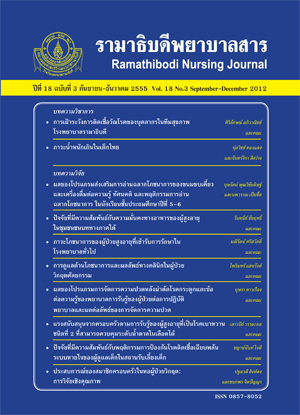วิธีปฏิบัติใหม่แบบลดการปนเปื้อนในการผ่าตัดเพื่อลดอัตราการติดเชื้อ แผลผ่าตัด
Main Article Content
Abstract
บทคัดย่อ
การวิจัยนี้เป็นการพัฒนางานประจำไปสู่การทำวิจัย (Routine to Research) เพื่อ เปรียบเทียบอัตราการติดเชื้อของแผลผ่าตัดระหว่างการใช้วิธีปฏิบัติใหม่แบบลดการปนเปื้อนใน ขณะผ่าตัดกับวิธีปฏิบัติแบบปกติในผู้ป่วยที่ได้รับการผ่าตัดตับ ระบบทางเดินน้ำดีและลำไส้ใหญ่ หลักการของวิธีปฏิบัติใหม่คือ การแยกอุปกรณ์และผ้าต่าง ๆ ที่ปนเปื้อนออกจากสิ่งของที่สะอาด และการนำอุปกรณ์และผ้าที่ปนเปื้อนออกจากบริเวณผ่าตัดทันที กลุ่มตัวอย่างคือผู้ป่วยผ่าตัดตับ ระบบทางเดินน้ำดีและลำไส้ใหญ่ที่ได้รับการผ่าตัดในห้องผ่าตัดศัลยศาสตร์ โรงพยาบาลรามาธิบดี ระหว่างเดือนมกราคม ถึงมิถุนายน พ.ศ. 2548 จำนวนทั้งสิ้น 121 ราย ไม่รวมการผ่าตัดหลายอวัยวะ (multi-procedures) ซึ่งมีจำนวน 43 ราย มีผู้ป่วยที่เข้าร่วมการศึกษาจำนวน 78 ราย พยาบาลหน่วย ป้องกันและควบคุมการติดเชื้อเฝ้าระวังติดตามผู้ป่วยจนกระทั่ง 30 วันหลังผ่าตัด โดยติดตาม จากเวชระเบียนของผู้ป่วย ซึ่งติดตามได้ครบ 65 ราย และพบว่ามีการติดเชื้อแผลผ่าตัดจำนวน 8 ราย (ร้อยละ 12.3) โดยพบแผลผ่าตัดติดเชื้อ 1 ราย (ร้อยละ 4.6) ในกลุ่มผู้ป่วยที่ใช้วิธีปฏิบัติ ผ่าตัดแบบลดการปนเปื้อนจำนวน 22 ราย และพบแผลผ่าตัดติดเชื้อ 7 ราย (ร้อยละ 16.3) ใน กลุ่มที่ใช้วิธีปฏิบัติแบบปกติจำนวน 43 ราย แต่ไม่มีความแตกต่างกันอย่างมีนัยสำคัญทางสถิติ อย่างไรก็ตาม ความแตกต่างนี้ถือว่ามีนัยสำคัญทางคลินิก เนื่องจากการผ่าตัดด้วยวิธีปฏิบัติแบบ ลดการปนเปื้อนมีการติดเชื้อแผลผ่าตัดน้อยกว่าวิธีปฏิบัติแบบปกติถึงร้อยละ 72 ดังนั้น ควรมี การศึกษาติดตามต่อไปในกลุ่มตัวอย่างที่มากขึ้น น่าจะทำให้ทราบผลของวิธีปฏิบัติใหม่แบบลด การปนเปื้อนต่ออัตราการติดเชื้อชัดเจนขึ้น
คำสำคัญ : วิธีปฏิบัติแบบลดการปนเปื้อน, การติดเชื้อแผลผ่าตัด, งานประจำไปสู่งานวิจัย
Abstract
The objective of this study was to compare the surgical site infection rate between the group using a new contamination-reducing procedure and the group using usual intraoperative practice in patients undergoing opened bile duct, liver, pancreas, and colon surgery. The principle of the new procedure is immediately separating contaminated devices and surgical apparel out of the operative field. The sample consisted of patients undergoing high-risk surgical procedures, defined as opened bile duct, liver, pancreas and colon procedures, at Ramathibodi Hospital during the period from January to June 2005. Initially, 121 patients were enrolled, but 43 of them had undergone multiple-organ procedures and were excluded from the analysis. All 78 eligible patients were monitored for evidence of wound infection until hospital discharge. Medical records were reviewed from the period between immediate postoperative to Day 30 after the primary operation. Only 65 patients had completed medical records up to 30 days after operation; of these, 12.3% had surgical site infection. One of the 22 patients in the new practice group (4.6%) had surgical site infection, while 7 of the 43 patients in the usual practice group (16.3%) had surgical site infection, but this difference was not significant. However, this difference is regarded as clinical significance because the contamination-reducing procedure group had a 72% lower infection rate than the usual practice group. Yet, this technique should be further studied in a larger sample size so that the significant difference may be found obviously.
Keywords : Contamination-reducing procedure, Surgical site infection, Operating room, Routine to research
Article Details
บทความ ข้อมูล เนื้อหา รูปภาพ ฯลฯ ที่ได้รับการตีพิมพ์ในรามาธิบดีพยาบาลสาร ถือเป็นลิขสิทธิ์ของวารสาร หากบุคคลหรือหน่วยงานใดต้องการนำทั้งหมดหรือส่วนหนึ่งส่วนใดไปเผยแพร่หรือเพื่อกระทำการใด ใด จะต้องได้รับอนุญาตเป็นลายลักษณ์อักษรจากรามาธิบดีพยาบาลสารก่อนเท่านั้น


